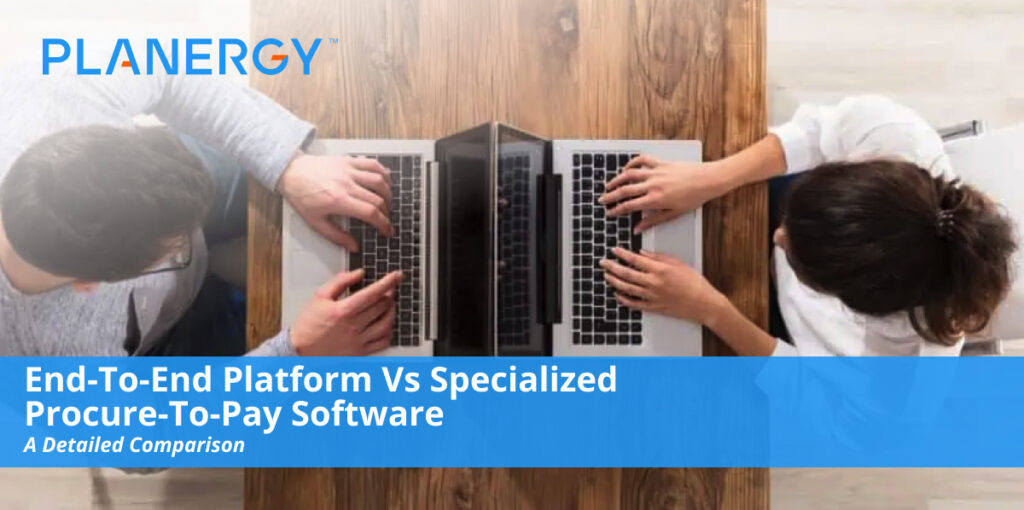For small businesses, finding the right software solutions to address procurement and inventory management needs while managing to integrate everything with current business processes can be quite an undertaking.
That’s why procurement teams need to consider using an end-to-end platform rather than a specialized procure to pay solution.
End-to-End Platform vs Specialized Procure-to-Pay Software
End-to-end platforms handle everything a business needs across the board, with integrations and third-party applications to make it simpler to manage operations.
In terms of procurement, it handles everything from strategic sourcing and contract management to e-procurement and e-invoicing, supplier management, and more.
These platforms, such as SAP, Oracle, and Ariba, aren’t widely available for the procurement sector, and they each sell a set of solutions that may or may not be tightly integrated.
They definitely aren’t built on or delivered on a single platform environment.
Specialized procure-to-pay (P2P) software on the other hand, just addresses the procure-to pay solution, or purchase-to-pay cycle from inquiry to payment for goods and services for each order that goes through a business.
It addresses:
Supply Chain Management: The method you use to connect to suppliers and manage supplier relationships for ordering purposes.
Vendor selection: Researching and choosing the vendor you want to purchase goods and services from.
Requisitioning: Your company’s internal process of getting formal approval to place an order with the vendor.
Purchase Order: The formula document that contains the specific information about the items and quantity being ordered and other requirements for the vendor.
Receiving: Accepting the physical shipment into inventory and accounting systems.
Invoice Reconciliation: Comparing the items received in the order to the purchase order and the invoice to ensure the costs are as they should be.
Accounts Payable: The final step in the process handles the payment processing for the items on the purchase order. It sends the necessary payment to the vendor and records it in the accounting system.
Small businesses may not need specialized procurement software in the beginning, but as their company grows, it’s something they’ll want to consider. Investing in an end-to-end management solution early will help ease the growing pains many businesses endure.
Benefits of a Single End-to-End Platform
Integration with External Systems
You can integrate with your enterprise resource planning solution (ERP) much easier because of the simplified technical environment.
It may even improve because you’ll have the ability to expose third-party systems data anywhere in the application.
Integration Within the Application Suite Itself
You’ll even have some out of the box benefits, such as integrated supplier management and sourcing abilities that re built on the same underlying architecture and data model.
Reduced Integration Costs Between Procurement Modules
For instance, item or vendor master integration may link a supplier portal, supplier management tools, supplier masters and item master.
In the case of a multi-tool environment, integration costs can be quite significant, even within procurement-related applications. This approach is far more cost effective over the long-term.
Single Data Model
With the single data model and single supplier combination, you can easily take things down to the item level for better spend analysis and spend management.
This in itself has numerous benefits to your company’s bottom line because you can not only see who is spending what and on what goods and services, but it makes it easier to spot cost savings opportunities.
Build a Consistent User Interface for Better User Experience
You’re more easily able to build user interface (UI) consistency and navigation beyond using a single sign-on technology.
With a consistent UI, you improve user experience across the board and make things easier for your staff to use, which contributes to higher productivity.
With traditional integrated tools that appear to be a single platform, but are in actuality built on multiple platforms, the UI can change frequently, creating issues with usability.
Increased Cross-Module Development Speed
With this kind of setup, you’ll generally find you’ll be able to speed up your release schedules, and you’ll have greater integrated functional enhancements with each release. It’ll be easier to upgrade overall, too.
Reduced Bugs in Upgrade Processes
As you upgrade things in your single suite environment, you’ll find fewer bugs overall, and be able to get rid of the bugs you do find faster than you used to be able to.
Deployment Agnostic
You can deploy it as a SaaS solution in the cloud, on your own servers in the cloud or on-premises, or in some sort of hybrid approach.
End-to-end providers don’t dictate how you deploy your management system, but rather allow you to follow your own business and IT strategy.
Many solutions are focused on cloud-based deployment because that’s where valuations are.
You’re Not Solely Dependent on Your Provider
Most service providers will have a roadmap and bug fix releases they’ll advise you to stick to. You, of course, can do this if you wish, but you don’t have to depend on them. You can deploy everything on site effectively, and fast.
A truly single platform provider will over you the tools to keep site specific changes, versions, and all your upgrades in line so you don’t lose your upgrade path.
There are so many benefits to using an end-to-end platform, it’s hard to make a case for using a specialized procure-to-pay software.
Though it may take some time to find the right end-to-end platform to use within your business, you’ll find your company reaping the benefits quickly after implementation.




